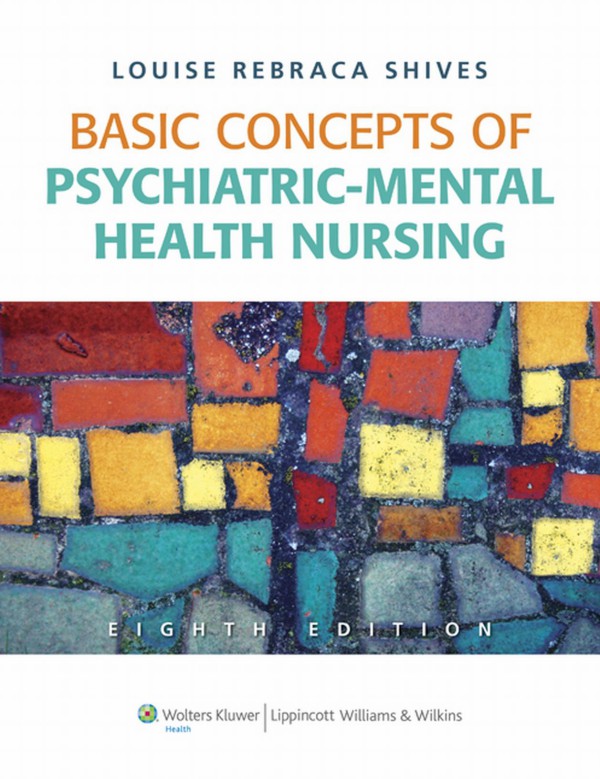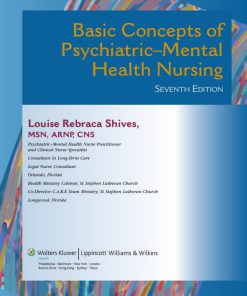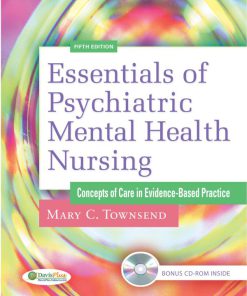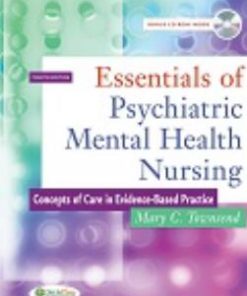Basic Concepts of Psychiatric Mental Health Nursing 8th Edition by Louise Rebraca Shives 9781605478876 1605478873
$50.00 Original price was: $50.00.$25.00Current price is: $25.00.
Authors:Unknown , Author sort:Unknown
Basic Concepts of Psychiatric Mental Health Nursing 8th Edition by Louise Rebraca Shives – Ebook PDF Instant Download/Delivery.9781605478876,1605478873
Full download Basic Concepts of Psychiatric Mental Health Nursing 8th Edition after payment
Product details:
ISBN 10:1605478873
ISBN 13:9781605478876
Author:Louise Rebraca Shives
This is a core textbook for the LPN and ADN psychiatric-mental health course. This textbook presents succinct, yet comprehensive coverage of topics for the short or integrated psychiatric-mental health course. The goal of the Eighth Edition has been to address current issues and trends in psychiatric–mental health nursing to foster competency in the delivery of mental health care addressing lifespan, diversity and disparities in access to care. It also retains key features that have been well-received in previous editions – specifically self-awareness prompts, clinical examples, and recurring boxes.
Basic Concepts of Psychiatric Mental Health Nursing 8th Table of contents:
UNIT I: Psychiatric–Mental Health Nursing
1: Self-Awareness
LEARNING OBJECTIVES
KEY TERMS
SELF-AWARENESS
SELF-AWARENESS PROMPT
FREQUENTLY ASKED QUESTIONS BY STUDENT NURSES
Will the Client Know That I Am a Student Nurse?
How Do I Introduce Myself?
What Do I Wear?
What if I Say the Wrong Thing?
Will I Be Left Alone with a Client?
What if the Client Becomes Violent?
RECOMMENDATIONS BY STUDENT NURSES
KEY CONCEPTS
CHAPTER WORKSHEET
Critical Thinking Questions
Reflection
NCLEX-Style Questions
REFERENCES
SUGGESTED READINGS
2: History and Trends in Psychiatric–Mental Health Nursing
LEARNING OBJECTIVES
KEY TERMS
CONCEPT OF MENTAL HEALTH
Factors Influencing Mental Health
Genetic Characteristics
Nurturing During Childhood
Life Circumstances
SUPPORTING EVIDENCE FOR PRACTICE 2.1: The Relationship Between Environment and Mental Health
Characteristics of Mental Health
FIGURE 2-1
Factors Affecting Mental Health Maintenance
Interpersonal Communication
BOX 2.1: Five Levels of Communication
Ego Defense Mechanisms
TABLE 2.1: Definition and Examples of Commonly Used Ego Defense Mechanisms
Significant Others or Support People
SELF-AWARENESS PROMPT
BOX 2.2: Examples of Situations Involving the Use of a Support Person
Personal Strategies for Mental Health Maintenance
BOX 2.3: Personal Strategies for Reducing Stress and Enhancing Well-Being
SELF-AWARENESS PROMPT
CONCEPT OF MENTAL ILLNESS
TABLE 2.2: Characteristics of Mental Health and Mental Illness
Stigma and Perceptions About Mental Illness
Diagnosis of a Mental Illness
HISTORICAL DEVELOPMENT OF PSYCHIATRIC–MENTAL HEALTH NURSING
Middle Ages to 1773
1773 to 1956
TABLE 2.3: Development of Psychiatric–Mental Health Nursing
Other Developments Since the 1950s
SELF-AWARENESS PROMPT
TABLE 2.4: Events Influencing Psychiatric–Mental Health Nursing
BOX 2.4: Results of Research on Biologic Aspects of Mental Illness
PSYCHIATRIC–MENTAL HEALTH NURSING: SCOPE AND STANDARDS OF PRACTICE
BOX 2.5: Standards of Practice
BOX 2.6: Standards of Professional Performance
PSYCHIATRIC–MENTAL HEALTH NURSING TODAY
Education
Licensed Practical or Vocational Nursing Programs
Associate’s Degree Nursing Programs
Baccalaureate Degree Nursing Programs
Master’s Degree Nursing Programs
Continuing Education
BOX 2.7: Certification Organizations
Career Opportunities
TABLE 2.5: Use of Psychiatric–Mental Health Nursing Skills in Career Opportunities
Expanded Role of the Psychiatric–Mental Health Nurse
KEY CONCEPTS
CHAPTER WORKSHEET
Critical Thinking Questions
Reflection
NCLEX-Style Questions
REFERENCES
SUGGESTED READINGS
3: Development of Psychiatric–Mental Health Nursing Theory
LEARNING OBJECTIVES
KEY TERMS
TABLE 3.1: Theoretical Frameworks Influencing the Development of Psychiatric Nursing Theory
TABLE 3.2: Chronology of Nursing Theorists and Theories
NURSING THEORY AND RESEARCH
Nursing Theories
Peplau’s Interpersonal Theory
Orem’s Behavioral Nursing Theory
Roy’s Theory of Adaptation
Parse’s Theory of Human Becoming
SELF-AWARENESS PROMPT
Leininger’s Theory of Cultural Care Diversity and Universality
APPLICATION TO PRACTICE
Needs-Oriented Approach
Interaction-Oriented Approach
Outcome-Oriented Approach
Eclectic Approach
AGREEMENT AMONG NURSING THEORISTS
KEY CONCEPTS
CHAPTER WORKSHEET
Critical Thinking Questions
Reflection
NCLEX-Style Questions
REFERENCES
SUGGESTED READINGS
UNIT II: Special Issues Related to Psychiatric–Mental Health Nursing
4: Spiritual, Cultural, and Ethnic Issues
LEARNING OBJECTIVES
KEY TERMS
SPIRITUALITY
CULTURE AND NURSING
SELF-AWARENESS PROMPT
Culturally Congruent Nursing Care
SELF-AWARENESS PROMPT
POPULATION GROUPS
USE OF MENTAL HEALTH SERVICES BY ETHNIC GROUPS
Nature of the Mental Health System
Socioeconomic Status of Ethnic Groups
CULTURAL PERCEPTIONS: MENTAL ILLNESS AS A SPIRITUAL CONCERN
CLINICAL EXAMPLE 4.1: Culturally Competent Care for the Client with Schizophrenia
CULTURAL PERCEPTIONS: MENTAL ILLNESS AS IMBALANCE OR DISHARMONY IN NATURE
CULTURAL EXPRESSIONS OF MENTAL ILLNESS AND NURSING IMPLICATIONS
TABLE 4.1: Culture-Bound Syndromes
PSYCHIATRIC NURSING OF ETHNIC GROUPS
Ethnopharmacologic Considerations
TABLE 4.2: Selected Cultural Implications of Psychotropic Agents
Nursing Implications
Role of Family
Nursing Implications
Role of Healers
TABLE 4.3: Healers and Their Scope of Practice
Nursing Implications
Role of Translators
Nursing Implications
THE NURSING PROCESS
Assessment
BOX 4.1: Brief Cultural Assessment Guide for a Client with a Mental Illness
Nursing Diagnoses and Outcome Identification
TABLE 4.4: Nursing Diagnoses and Statements of Outcome for Clients from Diverse Cultures
Implementation
Establishing a Trusting Relationship
SELF-AWARENESS PROMPT
Communicating With the Client and the Family
Incorporating Cultural Beliefs
Evaluation
NURSING PLAN OF CARE 4.1: THE CLIENT FROM A DIFFERENT CULTURE
KEY CONCEPTS
CHAPTER WORKSHEET
Critical Thinking Questions
Reflection
NCLEX-Style Questions
REFERENCES
SUGGESTED READINGS
5: Ethical and Legal Issues
LEARNING OBJECTIVES
KEY TERMS
ETHICS IN NURSING
BOX 5.1: Code of Ethics for Nurses—Provisions
Model of Ethical Nursing Care
BOX 5.2: Examples of Nursing Resources on Ethics
Ethics in Pain Management
BOX 5.3: Examples of Ethical Dilemmas Associated With Pain Management
Ethics in Genetic Testing and Clinical Research
LEGAL ISSUES IN NURSING
BOX 5.4: The American Nurses Association’s Bill of Rights for Registered Nurses
Malpractice
BOX 5.5: Potential Legal Issues in Psychiatric–Mental Health Nursinga
Breaches of Client Confidentiality and Privacy
BOX 5.6: HIPAA Privacy Provisions Rule
Failure of Duty to Warn
Bill of Rights for Psychiatric–Mental Health Clients
SELF-AWARENESS PROMPT
Advance Psychiatric Directives
Psychiatric Hospitalization
Hospitalization of Minors
Long-Term Care Facilities
FORENSIC PSYCHIATRY
BOX 5.7: Elements of Mental Competency to Stand Trial
Role of the Forensic Nurse
SELF-AWARENESS PROMPT
The Forensic Nurse as a Legal Nurse Consultant and an Expert Witness
KEY CONCEPTS
CHAPTER WORKSHEET
Critical Thinking Questions
Reflection
NCLEX-Style Questions
REFERENCES
SUGGESTED READINGS
6: Forensic Nursing Practice
LEARNING OBJECTIVES
KEY TERMS
INTRODUCTION TO FORENSIC NURSING PRACTICE
HISTORY OF FORENSIC NURSING PRACTICE
SCOPE OF FORENSIC NURSING PRACTICE
Unique Characteristics of Forensic Nursing
BOX 6.1: Examples of Forensic Nursing Scope of Practice
STANDARDS OF FORENSIC NURSING PRACTICE
SELF-AWARENESS PROMPT
THE FORENSIC NURSE’S CODE OF ETHICS
BOX 6.2: Forensic Nursing Responsibilities and Obligations
FORENSIC NURSING EDUCATION
SELF-AWARENESS PROMPT
CLINICAL EXAMPLE 6.1: Investigation of Violent Behavior
Functions of the Forensic Nurse
BOX 6.3: Examples of Forensic Nursing Education Programs
Practice Areas
Special Roles of the Forensic Nurse
BOX 6.4: Practice Areas of Forensic Nurses
KEY CONCEPTS
CHAPTER WORKSHEET
Critical Thinking Questions
Reflection
NCLEX-Style Questions
REFERENCES
SUGGESTED READINGS
7: Loss, Grief, and End-of-Life Care
LEARNING OBJECTIVES
KEY TERMS
LOSS
Types of Loss
BOX 7.1: Examples of Losses Identified by Student Nurses
GRIEF
Grief Theory
BOX 7.2: Five Stages of Grief Identified by Kübler-Ross
Unresolved or Dysfunctional and Disenfranchised Grief
SELF-AWARENESS PROMPT
END-OF-LIFE CARE
Advance Care Planning
BOX 7.3: Five Wishes
Ethnic Considerations and Cultural Sensitivity
Palliative Care and Hospice Care
Manifestations of Suffering
BOX 7.4: Common Responses Associated with Suffering at End of Life
Pain
BOX 7.5: ABCDE Mnemonic of Pain Management
The Act of Dying
SUPPORTING EVIDENCE FOR PRACTICE 7.1: Providing Interventions for End-of-Life Ethical Concerns of Clients in the Psychiatric–Mental Health Clinical Setting
TABLE 7.1: Needs of Dying Persons and Survivors
BOX 7.6: The Dying Person’s Bill of Rightsa
Spiritual Needs
CHILDREN AND DEATH
SELF-AWARENESS PROMPT
TABLE 7.2: Research Results: Mourning the Death of a Parent from Cancer
KEY CONCEPTS
CHAPTER WORKSHEET
Critical Thinking Questions
Reflection
NCLEX-Style Questions
REFERENCES
SUGGESTED READINGS
8: Continuum of Care
LEARNING OBJECTIVES
KEY TERMS
FIGURE 8-1
INPATIENT CARE
Acute Care Facilities
FIGURE 8-2
Subacute Care Units
Long-Term Care Facilities
COMMUNITY MENTAL HEALTH
Historical Development of Community Mental Health
TABLE 8.1: Examples of Creative Community-Based Mental Health Programs
Types of Community Mental Health Services
Psychiatric Emergency Care
Day-Treatment Programs
BOX 8.1: Examples of Day-Treatment Program Interventions
Residential Treatment Programs
BOX 8.2: Examples of Residential Treatment Program
Psychiatric Home Care
Aftercare and Rehabilitation
BOX 8.3: Therapeutic Services Provided by Community Mental Health Centers (CMHCs)
Role of the Community Mental Health Nurse
THE CONTINUUM OF CARE IN THE 21ST CENTURY
SELF-AWARENESS PROMPT
KEY CONCEPTS
CHAPTER WORKSHEET
Critical Thinking Questions
Reflection
NCLEX-Style Questions
REFERENCES
SUGGESTED READINGS
UNIT III: Components of the Nurse–Client Relationship
9: Assessment of Psychiatric–Mental Health Clients
LEARNING OBJECTIVES
KEY TERMS
FIGURE 9-1
CLIENT ASSESSMENT
Types of Assessment
FIGURE 9-2
Cultural Competence During Assessment
COLLECTION OF DATA
Appearance
Affect or Emotional State
BOX 9.1: Types of Affective Responses
Behavior, Attitude, and Coping Patterns
Communication and Social Skills
Impaired Communication
Blocking.
Circumstantiality.
Clang Association.
Echolalia.
Flight of Ideas.
Looseness of Association.
Mutism.
Neologism.
Perseveration.
Tangentiality.
Verbigeration.
Word Salad.
Content of Thought
Delusions
TABLE 9.1: Types of Delusions Frequently Reported
Hallucinations and Illusions
TABLE 9.2: Types of Hallucinations
Depersonalization
Obsessions
Compulsions
Orientation
TABLE 9.3: Levels of Orientation and Consciousness
Memory
Intellectual Ability
Insight Regarding Illness or Condition
Spirituality
FIGURE 9-3
Sexuality
Neurovegetative Changes
Sleep Pattern
SUPPORTING EVIDENCE FOR PRACTICE 9.1: Nursing Assessment and Interventions for Clients in the Psychiatric–Mental Health Setting Who Experience Insomnia
BOX 9.2: Common Sleep Disorders
MEDICAL ISSUES
Pain
Physiological Responses to Medication
Supporters or Caregivers Assessment
DOCUMENTATION OF ASSESSMENT DATA
SELF-AWARENESS PROMPT
Examples of Documentation
BOX 9.3: Example of DAP Nursing Progress Notes
KEY CONCEPTS
CHAPTER WORKSHEET
Critical Thinking Questions
Reflection
NCLEX-Style Questions
REFERENCES
SUGGESTED READINGS
10: Nursing Diagnosis, Outcome Identification, Planning, Implementation, and Evaluation
LEARNING OBJECTIVES
KEY TERMS
NURSING DIAGNOSIS
TABLE 10.1: Classifications of Nursing Diagnoses
Diagnostic Systems
BOX 10.1: Examples of Nursing Diagnoses in Psychiatric–Mental Health Nursing
Diagnostic and Statistical Manual of Mental Disorders, 4th Edition, Text Revision (DSM-IV-TR)
BOX 10.2: DSM-IV-TR Multiaxial System
Decision Trees for Differential Diagnoses
Psychodynamic Diagnostic Manual (PDM)
Mnemonics
SELF-AWARENESS PROMPT
OUTCOME IDENTIFICATION
PLANNING
FIGURE 10-1
Plan of Care
IMPLEMENTATION
SELF-AWARENESS PROMPT
EVALUATION
NURSING PLAN OF CARE 10.1: THE CLIENT WITH INSOMNIA RELATED TO DEPRESSED MOOD
KEY CONCEPTS
CHAPTER WORKSHEET
Critical Thinking Questions
Reflection
NCLEX-Style Questions
REFERENCES
SUGGESTED READINGS
11: Therapeutic Communication and Relationships
LEARNING OBJECTIVES
KEY TERMS
COMMUNICATION
Factors Influencing Communication
FIGURE 11-1
Attitude
Values
Gender
Sociocultural or Ethnic Background
Past Experiences
Knowledge of Subject Matter
Ability to Relate to Others
Interpersonal Perceptions
Environmental Factors
Types of Communication
Verbal Communication
Nonverbal Communication
Vocal Cues
People also search for Basic Concepts of Psychiatric Mental Health Nursing 8th:
vibroverb reissue schematic
louise shivers
louise rebraca shives
rebecca louise ballet
rebecca louise barre workout
You may also like…
eBook PDF
Psychiatric Mental Health Nursing 4th Edition by Sheila Videbeck ISBN 0781764254 9780781764254













